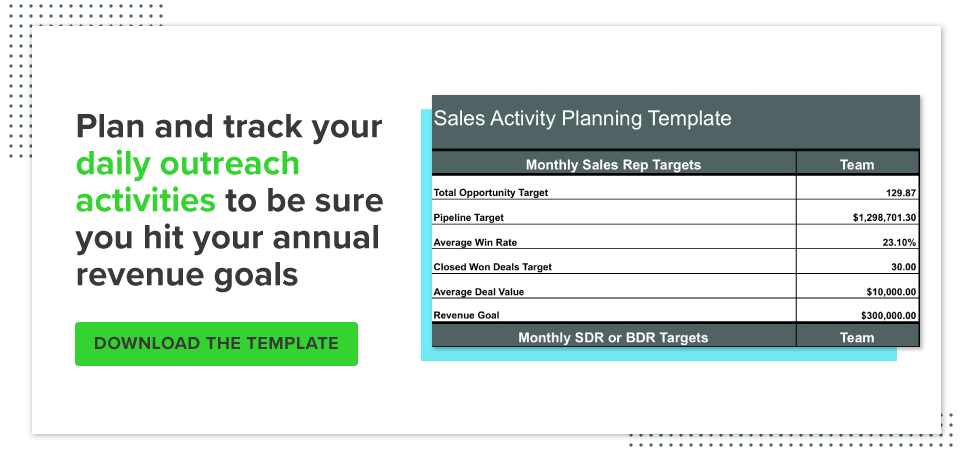Tips for Setting and Accomplishing Sales Goals

When it comes to sales goals, it goes without saying that most businesses have one ultimate goal in mind — bringing in revenue.
It can become easy for salespeople to focus on one thing — closing more high-value deals. While we all would like to be able to do that, doing so is not always a practical goal for your business, let alone the individual members of your sales team. Not every sales representative is suited for closing large deals and focusing solely on them may not lead to a diversified pipeline.
I sat down with New Breed’s Manager of Inside Sales, Beth Abbott, to hear more about what it takes to set realistic sales goals that put team members in a position to accomplish them and grow their business.
Sales Goals to Consider
Generally speaking, many of the goals you set for teams and individuals should track up to revenue, but you also have to consider goals that help you create sustainable growth. That means thinking about your team’s process, efficiency and the types of deals your team pursues.
“You should be thinking about the mix of revenue, including by channel or different segments of revenue like from your ideal customer profiles,” says Beth. “Those targets directly influence your end-goal of revenue.”
For example, setting goals to expand revenue coming from small businesses will ultimately impact the prospects your team seeks to work with more than a catch-all revenue goal would.
Secondary to these revenue goals, consider how you are working to make your teams more efficient or each deal more valuable than the last. If your sales team spends a lot of extra hours and calories to close deals, think about setting goals to decrease customer acquisition cost or increase your sales velocity.
“You should seek to improve these numbers while you’re also increasing your average deal size or the average lifetime value of your clients,” says Beth.
Tips for Setting Sales Goals
With an understanding of the goals you should be aiming for, the next question is the tangible metrics you should set for both your team and your individual reps.
Work backward from revenue
You may have a revenue goal, but you also have to determine the milestones your team and your individual reps need to reach in order to accomplish that goal.
For example, you can leverage historical data to determine how many MQLs, SQLs and opportunities you need to create in order to reach your target for revenue, as well as the individual activities reps need to complete.
“Depending on what it takes for your leads to reach the next stage, what are the activity goals that each sales rep needs to achieve that conversion,” says Beth.
For example, if your sales rep needs to send five outreach emails to book one discovery call and generate an SQL, then their goal of five SQLs should be accompanied by a goal of 25 outreach emails sent.
Obviously, different businesses will have different definitions of what it takes to be an SQL or what it takes to become an opportunity. That said, having visibility into sub-goals to a greater revenue goal is a great way to keep your sales reps on track and motivated.
Don’t set blanket metrics
While these secondary metrics are helpful, it’s important to set individual sales goals in addition to your greater team goals. Every sales rep is different. They have different strengths and weaknesses, and, depending on the structure of your team, may even work with different prospects.
“One rep on my team might have an average deal size of $80,000, while another might be $20,000,” says Beth. “So, what they actually have to do individually to contribute to the team is going to look very different from one another.”
If an individual sales rep closes a large quantity of low-value deals, they may need to do more outreach than a sales rep who closes a few high-value deals.
That’s why you should consider each rep’s historical data when setting their goals including their conversion rates between various lifecycle stages and the number of deals they need to close to contribute to the greater team deal.
When onboarding new team members, you can certainly use team or industry benchmarks while you collect data on their performance to set more personalized goals.
Be realistic
Much like your greater business goals, your sales goals should be something your team can realistically achieve.
“Your understanding of your historic funnel metrics and sales cycle should inform your future goals,” says Beth.
If you set goals that drastically exceed your previous achievements or that expect reps to complete more outreach than they would have time for then it’s unlikely you’ll be able to achieve them.
In the same vein, you also have to be realistic about measuring your goals. If you have a long sales cycle, having monthly quotas may be less effective than quarterly quotas.
How to Accomplish Your Goals
With the right sales goals established, your team can now start working toward accomplishing them.
Consider your incentives
Most sales teams work around incentives, so leveraging them to drive results or promote certain behaviors makes a lot of sense.
“You can promote new or preferred behaviors on your team either by amending or adding goals or providing the right incentive,” says Beth.
If you have multiple products you’re trying to sell at different price points, sales reps may only attempt to sell the higher-priced product as it makes them more likely to reach their goals.
In this case, a secondary goal with a separate incentive from the main revenue goal can promote selling across price points or product segments.
Track and identify gaps
In order to better accomplish individual sales goals, your team members need to understand where their biggest gaps are.
This places some level of responsibility on reps to track their activities regularly as well as on managers to hold their teams accountable for doing so.
If you’re working backward from revenue as recommended, you can uncover where reps are struggling. Do they have difficulty converting opportunities into customers? Are their outreach emails ineffective at booking discovery calls?
By identifying these gaps, managers and team leads can allocate time for sales coaching to improve these areas and make it easier for reps to accomplish their goals.
Keep a diverse pipeline
While this can differ from industry-to-industry depending on your sales process, it’s usually a good idea to keep a diverse pipeline. One might say not to put all of your eggs in one basket.
“You don’t want to be the one that spends all of their time on smaller deals that will have a quick sales cycle and avoid long-term opportunities,” says Beth. “In the same way, you don’t want to have two large opportunities and avoid the smaller quick wins.”
Small deals may not accumulate enough while larger deals may not pan out, leaving some reps well short of achieving their goals. Keeping a diverse pipeline enables reps to distribute their risk and keep the momentum going month-to-month.
Manage time effectively
Building off the idea of a diverse pipeline, sales reps should also be adequately balancing their time working opportunities and creating pipeline for the future.
“If you spend all of your time working opportunities, what happens when all of those opportunities close is that you no longer have any pipeline,” says Beth.
Unless time is divided among trying to close deals and nurturing new opportunities, momentum can stall and deals can dry up, making it difficult for reps to reach their goals consistently.
With that in mind, it’s important to train your reps effectively and ensure they leverage platforms like your CRM to keep track of their pipeline and open deals.
“From a coaching and technology perspective, are we enabling reps to spend time in the right places?” asks Beth.
At the same time, ensuring strong alignment between your marketing and sales teams can also help make better use of your sales team’s time. If your marketing team is creating assets or providing enablement materials that could support your sales team, then reps can spend more time on priority tasks like selling and creating pipeline.
Takeaway
At the end of the day, the key to setting realistic sales goals and subsequently accomplishing them is leveraging accurate tracking information. This data directly informs the goals you set as well as the coaching you provide your team members to better enable their success.
This post was originally published on May 7, 2014.
Chris Singlemann
Chris is a Brand Marketer at New Breed where he is responsible for crafting design and video assets that support our brand. When he's not behind the camera, he enjoys kayaking and tending to his sourdough starter.





